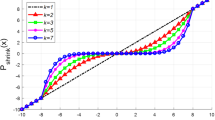Abstract
We propose a robust edge detection method based on ICA-domain shrinkage (independent component analysis). It is known that most basis functions extracted from natural images by ICA are sparse and similar to localized and oriented receptive fields, and in the proposed edge detection method, a target image is first transformed by ICA basis functions and then the edges are detected or reconstructed with sparse components. Furthermore, by applying a shrinkage algorithm to filter out the components of noise in ICA-domain, we can readily obtain the sparse components of the original image, resulting in a kind of robust edge detection even for a noisy image with a very low SN ratio. The efficiency of the proposed method is demonstrated by experiments with some natural images.
Similar content being viewed by others
References
Canny F J. A computation approach to edge detection. IEEE PAMI, 1986, 6: 670–700
Haralick M R. Digital step edges from zero crossings of the second directional derivative. IEEE PAMI, 1984, 6(1): 58–68
Pratt W K. Digital Image Processing. New York: Wiley Interscience, 1978
Bell A J, Sejnowski T J. The “Independent Components” of natural scenes are edge filters. Vision Res, 1997, 37: 3327–3338
Olshausen B A, Field D J. Emergence of simple-cell receptive field properties by learning a sparse code for natural images. Nature, 1996, 381: 607–609
Nowak R D, Baraniuk R. Wavelet domain filtering for photon imaging systems. IEEE Trans Image Proc, 1999, 8(5): 666–678
Bell A J, Sejnowski T J. An information-maximization approach to blind separation and blind deconvolution. Neural Comp, 1995, 7: 1129–1159
Lee T-W, Girolami M, Bell A J, et al. A unifying information-theoretic framework for independent component analysis. Comp Math Appl, 2000, 31(11): 1–21
Zhang X D, Zhu X L, Bao Z. Grading learning for blind source separation. Sci China Ser F-Inf Sci, 2003, 46(1): 31–44
Hoyer P. Independent component analysis in image denoising. Master’s Thesis. Helsinki University of Techonology, Eproo, 1999
Karvanen J, Cichocki A. Measuring sparseness in noisy signals. In: Proc. of ICA 2003, April 2003, Nara, Japan
Hyvarinen A, Oja E, Hoyer P. Image denoising by sparse code shrinkage. In: Haykin, Kosko B, eds. Intelligent Signal Processing. New York: IEEE Press, 2000
Nason G P. Wavelet shrinkage using cross-validation. J Royal Statistical Society Series B, 1996, 58: 463–479
Han X-H, Chen Y-W, Nakao Z. An ICA-based Method for Poisson Noise Reduction. KES 2003, Lecture Note in Artificial Intelligence, LNAI 2773. Berlin: Springer, 2003. 1449–1454
Author information
Authors and Affiliations
Corresponding author
Additional information
Supported by the Research Foundation of Education Bureau of Hunan Province, China (Grant No. 07B084) and Scientific Research Fund of Central South University of Forestry & Technology (Grant No. 06y005)
Rights and permissions
About this article
Cite this article
Han, X., Dai, S., Li, J. et al. Edge detection algorithm based on ICA-domain shrinkage in noisy images. Sci. China Ser. F-Inf. Sci. 51, 1349–1359 (2008). https://doi.org/10.1007/s11432-008-0114-1
Received:
Accepted:
Published:
Issue Date:
DOI: https://doi.org/10.1007/s11432-008-0114-1




